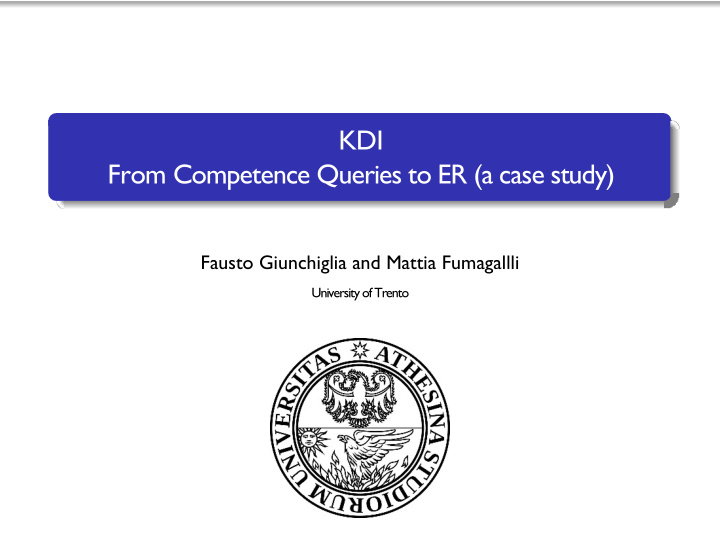



KDI From Competence Queries to ER (a case study) Fausto Giunchiglia and Mattia Fumagallli University of Trento
The Case Study Modeling recipes for online search - by Usashi Chatterjee, Fausto Giunchiglia, Devika P. Madalli, Vincenzo Maltese. - ODBASE 2016 -The 15th International Conference on Ontologies, DataBases, and Applications of Semantics, Rhodes – October, 25-26 2016
Heterogeneity in Recipes Websites … informal, heterogenous, terminology, different schema… 2/61
Heterogeneity in Recipes Websites Different Style: Different recipe websites cover different content following their own style and standard. Different Languag e: Some websites offer recipes not only in English but in Italian, German or Hindi language. Variant Terminology: myrecipes.com uses the term preparation, chow.com uses the term instruction, and kraftrecipes.com uses make it 3/61
The proposed solution 1 Propose a formalized entity-relationship(ER) model. 2 Modelling methodology is based on competency questions. 4/61
The proposed solution – A Methodology Identification Evaluation of of the query the model patterns Formalizing Building the the ER model ER model 5/61
Step 1: Identification of the query patterns • Competency queries are collected • Give me a recipe to prepare roasted turkey for Thanksgiving celebration • The queries are grouped in distinct scenarios • Give me a recipe to prepare roasted turkey for Thanksgiving celebration. • Give me a recipe of halal food prepared for Iftar party. • Give me breakfast recipes. 6/61
Query Analysis • Competency Question • Give me a recipe to prepare roasted turkey for Thanksgiving celebration • Competency Question Analysis • Give me all Recipe for Dish X AND Event Y WHERE X.name= “roasted turkey” AND Y.name = “Thanksgiving” AND recipeIngredient = Z AND Z.type = “turkey” AND cookingMethod = “roasting” • Identification Etypes and Properties • Etypes: RECIPE, DISH, EVENT • Property: Dish.name, Event.name, recipeIngredient.type, Recipe.cookingMethod 7/61
General Query Patterns • Identification of the general query pattern • Give me all recipes R which belong to cuisine C to prepare dish D appropriate for event E 8/61
Step 2: Building the recipe model • Common entity types • Those that can be (re-)used across domains • Core entity types • Are those returned by the queries • Auxiliary entity types • are those that in the general pattern determine how to filter results 9/61
Step 2: Building the recipe model 10/61
The proposed solution – A Methodology Identification Evaluation of of the query the model patterns Formalizing Building the the ER model ER model 11/61
Step 3: Formalization • RDF as formallanguage • Protégé standard free open source ontologyeditor 12/61
Step 4: Evaluation of the Model • Syntactic correctness and consistency • Completeness and conciseness • Empirical adequacy of the developed model 13/61
Step 5: Terminology comparison (example) 14/61
Comparative Study Schema.org ,BBC Food Ontology vs. Recipe Model Findings: q Incompleteness of properties Properties such as Recipe Creator and Recipe Rating is absent. q Lack of Types Schema.org and BBC Food Ontology does not associate recipes to specific event. q Underspecified properties Properties in Schema.org as plain text poses serious limitations to queries. q Lack of Structure Schema.org defines ingredient as text prevents it to answer queries related to quantities and qualifiers for ingredients. 15/61
Highlights of the Proposed Model Ø Addressed the diversity problem in websites Definition of a formal ER model captures the fundamentalqueries to be offered Ø The model is grounded in Library Science theories on creativeworks. Clear distinction between Recipe and Dish Ø Overcomes the limitations of existing models Schema.org and BBC food ontology 16/61
Recommend
More recommend